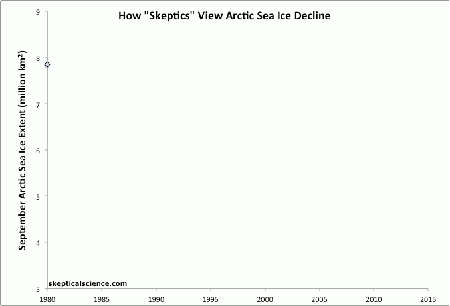
As some of you may know, 2012 was a record low for Arctic sea ice. This year, Arctic sea ice has increased by 60%, and some are using this fact to argue that global warming is not real. However, those making this case do not understand how statistics work. In particular, they fail to understand a statistical phenomenon known as Regression to the Mean. The basic idea here is that if one has a measurement that is particularly extreme, then the next measurement will be much closer to the average or mean. In the case of Arctic sea ice, since 2012 was a record low, we would expect that in the next year we would see an increase. As Dr. Steven Novella puts it in reference to the image above:
Dana Nuccitelli at The Guardian has a nice graphic showing Arctic sea ice trends from 1980 to this year. In this graph you can see the background fluctuation year to year, but also the clear downward trend overall. Another trend is also apparent – following any year with a record low Arctic ice measurement, the following year is likely to have increased total ice. This is simply regression to the mean. In any fluctuating system, extreme values are likely to be followed more average values. [sic]The upshot of this is that when we are looking at a complex phenomenon like climate change, we need to look at the whole picture to understand what is going on. If we simply pull out a small segment of the entire picture, say by just focusing on the years 2012 and 2013 (an example of Cherry Picking) it can seem like global warming is on the wane. However, if we pull back and take a broader look we can see that the trend for Arctic sea ice clearly shows that the amount is decreasing over time. And this provides further evidence that global warming is a real phenomenon.
No comments:
Post a Comment
Note: Only a member of this blog may post a comment.